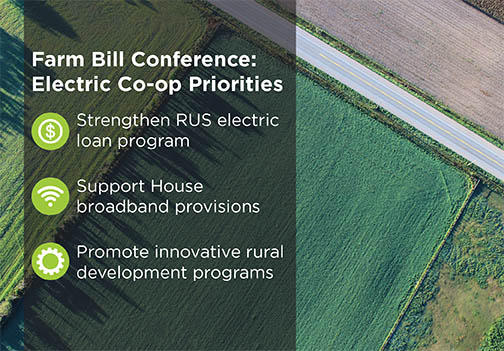 The U.S. House and Senate each passed versions of the Farm Bill this summer and are seeking to reach a compromise on the legislation in the fall.
The U.S. House and Senate each passed versions of the Farm Bill this summer and are seeking to reach a compromise on the legislation in the fall.
NRECA is urging lawmakers on the Farm Bill conference committee, tasked with coming up with the final version of the bill, to consider electric co-ops’ priorities.
“We are encouraging Congress to pass a final Farm Bill that supports several key policy issues for electric co-ops and their member-consumers in rural America,” said NRECA CEO Jim Matheson.
Here are the top priorities for co-ops:
Remove Senate changes to Rural UTILITIES SERVICE loan program
The House Farm Bill retains existing escrow accounts for co-op loan repayments and treatment of deposits into those accounts. The Senate-passed version eliminates the escrow or “cushion of credit” program that allows greater financial flexibility to co-ops and benefits the government by having funds pre-deposited toward loan payments.
“Cooperatives depend on the USDA’s electric loan program and its escrow treatment to serve the most rural, hardest-to-serve areas of the country,” said Matheson.
Promote true high-speed broadband for rural areas
The House version provides for significant financial investment in broadband development by electric co-ops and other providers in rural areas that have either no internet service or substandard service.
The Senate Farm Bill increases funds for rural broadband but provides only limited support for projects in areas with existing but inadequate service.
“Deployment of rural broadband is essential to keeping rural communities competitive,” said Matheson. “NRECA is working to ensure co-op member-consumers get high-speed internet service on par with the rest of the country.”
Include funds for rural economic development and innovation
Co-ops use the Rural Economic Development Loan and Grant Program (REDLG) to finance economic development projects, such as refurbishing a library or buying emergency response vehicles. Both bills reauthorize and improve the program through 2021. NRECA supports the Senate provision, which also provides $5 million for the program each year.



